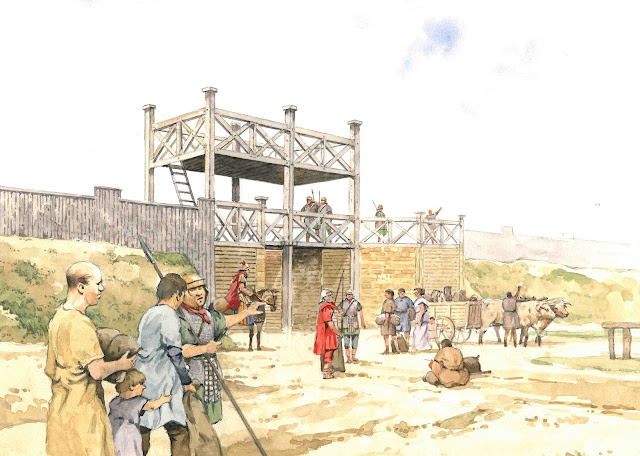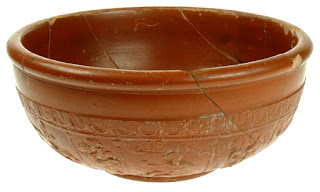This week we are celebrating the fascinating story of Castleford’s past as the Roman fort and settlement, Lagentium, and sharing many of the treasures from our Roman Castleford collection.
But how did these ancient objects come to be in Castleford Museum today?
And, given that the modern town has been built on top of the Roman remains, how do we even know about Lagentium?
Archaeologists arrive
Although people had taken an interest in Castleford’s Roman origins as early as the 16th century, it wasn’t until the mid 20th century that any modern archaeological excavations took place. However, some chance finds were presented to the museum collection, then part of Castleford Library, in the 1920s and 1930s. This roof tile found on Carlton Street and an oil lamp discovered at Albion Street were some of the first Roman objects to be preserved in the collection.In the 1960s significant redevelopment work in the town led to the discovery of many more Roman objects. Finds made during work to build a new bus station and bowling alley prompted a new interest in Castleford’s Roman heritage and the first systematic excavations took place. Initially these were mainly carried out by amateur archaeologists such as the Castleford and District Historical Society, until the late 1970s when their valuable work was continued by full time archaeologists from the West Yorkshire Archaeological Unit.
 |
| Volunteers excavating in Castleford |
The excavations in the second half of the 20th century revealed the remains of Roman buildings and structures and uncovered many Roman items and thousands of further fragments of objects. These allowed experts to piece together a plan of what Roman Castleford had looked like and helped to build a picture of what life was like at the time. They revealed the existence of two forts and a nearby town. The finds were donated to the museum collection to be preserved. Many are on display today and allow us to tell the story of life in Lagentium.
The first fort, AD 71-86
Whilst the exact footprint of the first fort is still unknown, excavations have uncovered the remains of several buildings from inside the fort’s defences.The discovery of leather fragments believed to be from soldiers’ tents suggests that the first Romans in Castleford didn’t have permanent sleeping areas. However, there is evidence in the form of foundations and post-holes to suggest that the army did go on to construct barracks and other timber buildings, including a granary to store the vital supplies of grain needed to feed the troops.
Archaeologists excavating near Back Bank Street discovered a large building believed to be at the centre of the fort. It had several rooms arranged around a central courtyard. A building of this size in a key location could have been the army’s local headquarters but the mix of military and domestic items found at the site suggest it was more probably the house of an army commander.
 |
| Foundation trenches for the timber walls of the house |
A load of rubbish?
We owe lots of what we have learned about the first fort at Lagentium to a rubbish dump! Near to Church Street, a pile of Roman waste had been preserved due to waterlogging. Normally, organic material would have rotted away but here archaeologists found leather remains, including these remarkably well preserved shoes.
The volume of leather offcuts discovered here along with metal remnants suggests it may have been the site of an army workshop or fabrica.
The many other finds also provide an invaluable insight into life in the fort. There is evidence also of medical provision, army administration and soldiers’ leisure time.
 |
| A scoop or probe, possibly used in the fort's hospital |
The second fort, c. AD 86
The first Lagentium fort was eventually demolished and the ground at the site levelled in preparation to build a new set of defences. Archaeologists have been able to identify the size, layout and location of the second fort at Lagentium because their excavations in the 1980s uncovered evidence of the fort’s defences, including ditches, ramparts, a gate and parts of the Roman road network. From this they have worked out that the fort stretched 8.4 acres from Back Bank Street in the north to Carlton Street in the south, and from Bradley Street in the east to Church Street in the west. Within these defences, they have identified the site of barrack blocks, warehouses and stables.
 |
| Artist's impression of how the gate and defences may have looked |
 |
| Archaeologists studied the pattern of post-holes for the timber uprights. |
The excavations revealed the existence of many timber buildings but also showed signs of a move within the second fort to more substantial structures, including stone foundations, tile roofs and even a large granary with stone walls.
As well as the two forts, archaeological excavations have also revealed the existence of a nearby civilian town, or vicus. The town would have provided the soldiers of the army garrison with goods and leisure services. Over time though, it grew into a significant trading centre and an important staging post on the Roman Empire’s message network. It seems to have been ideally located for this, focused mainly on the road leading to the River Aire crossing point.
Excavating the vicus
As well as the two forts, archaeological excavations have also revealed the existence of a nearby civilian town, or vicus. The town would have provided the soldiers of the army garrison with goods and leisure services. Over time though, it grew into a significant trading centre and an important staging post on the Roman Empire’s message network. It seems to have been ideally located for this, focused mainly on the road leading to the River Aire crossing point.
 |
| Plan showing the vicus to the south west of the fort on the Roman road |
Archaeologists have discovered that the vicus appears to have been arranged according to a planned regular layout. The buildings were constructed in rows to a standard size and floorplan, probably decided by the army. In these uniform buildings were workshops for craftsmen and shops for traders.
Life of luxury
There is evidence of significant redevelopment work in the vicus following the army’s eventual exit from the fort. The original timber buildings were replaced with larger premises and sometimes stone structures. Archaeologists have been able to identify gravel pathways that linked the buildings to each other and to the main road, and have even uncovered rut marks from the cartwheels that travelled over them.
Unlike other Roman settlements, Lagentium continued to develop after the garrison left, thriving as a manufacturing and commercial centre in the early 2nd century. Excavations of the vicus produced large quantities of luxury items. The high standard of the finely crafted jewellery and metalwork, and imported glassware, kitchenware and tableware paints a picture of a civilised population that had embraced Roman lifestyles. The discovery of many fragments of vessels known as amphorae tells us that the townspeople were enjoying food and drink from the continent. Amphorae would have been used to import fish sauce and olive oil from Spain and wine from France.
 |
| An example of an amphora |
It is also clear that Castleford had extensive trading links. Over 700 fragments of samian ware, a shiny red glazed crockery from France, were found in a single location. The sheer size of this find makes it one of the most important discoveries of samian ware in Britain and suggests that the excavated building was most probably a shop or warehouse, from which the surrounding area acquired its sophisticated tableware for impressing dinner guests at special occasions.
 |
| Examples of samian ware reconstructed from excavated fragments |
Thanks to the excavations of the late 20th century, we are able to better understand life in Castleford at the height of its Roman history. At Castleford Museum today we are proud to tell this story and to display objects that our predecessors in Lagentium crafted, bought and sold - items that they wore, used for eating and drinking, for bathing and cosmetics, or for fun and relaxation.
Only some of the Roman area has been excavated so far and there is yet more to discover in future.






No comments:
Post a Comment
We would love your comments - though they may take a day or two to appear.